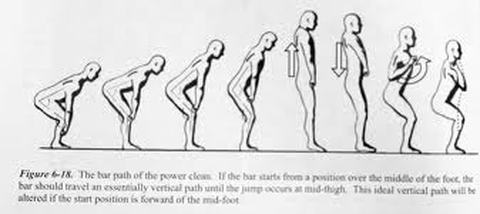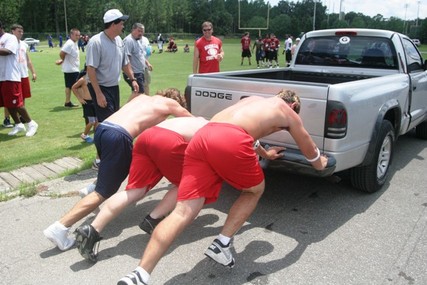Football players, ruggers, and all other contact sport athletes need to be big, strong, fast, mobile, agile and be covered in a suit of muscled up body armor to protect them from the other 20 maniacs running around knocking each other over. To have a successful team, most of the players need to have these attributes. Simply having one or two studs on the team with outstanding numbers can score you a few big plays, but will never win you a championship. When training in a team environment, we can't put our focus on what works for some guys some of the time. We need to put our focus into what works best for most people most of the time. Also, several factors need to be considered when training in a group environment, and the strength coaches job of managing the madness is trifold. The coach needs to manage his limited time with the athletes, the available space he has to train, and of course, the personnel he has to work with. How to accomplish this is dependent upon the philosophy of the organization.
The strength coach must also realize the needs of the players. These needs are obvious in most cases for any chosen sport. But needs for the individual are less obvious due to injuries, weaknesses and imbalances. Personalizing an individuals needs usually take a back seat in group training programs, as it becomes nearly impossible to monitor 75 different programs within a single group of athletes. Through time and experience, the coach will learn what special attention certain athletes will need depending on their positional requirements and personal issues. |

Football is not a healthy man's game and we don't play it for fitness. We are the modern day gladiators of team sport. Outside of martial arts, in no other sport does one get celebrated for hitting another man so hard, that bodily fluids get excreted from multiple orifices while simultaneously collapsing a lung, breaking a bone, or in any other way debilitating another human being. There are not many anatomical positions foreign to an average football player by the middle of a season. These guys get pushed, shoved, knocked down, kicked, punched, gorged, trampled, bulldozed, Russian sickled, Jimmy Supafly Snooka'd, banana hammocked and double-fish-hook-camel-clutched hundreds of times throughout the season. These guys know pain, trauma, agony and suffering, torn bones and broken ligaments. With the exception of the kicker, these guys live in pain for months on end.



Lets look at some of the basic exercises used in traditional football training, the power clean, deadlift, bench press and squat. While these are all classic movements that will get you strong, we are concerned with getting maximal transference to the field. There seems to be a polarized belief in many coaches programs that their teams training needs to be this way or that way, and differing from the predetermined system may not be welcomed. Fortunately, more coaches are starting to see the light and are beginning to incorporate unconventional training outside of the weight room. Every tool has its pros and cons. While a barbell is the best tool for microloading, it lacks organic movement by nature. In no other time in your life will you be lifting a perfectly balanced barbell outside of the weight room. But we have the option to utilize different tools to create a different stimulus, thus forcing the athlete to move in different planes of motion and forging a more complete athlete.

A power clean is a great exercise and I recommend it go into most football programs, but if the athlete performs it incorrectly it is not a great exercise any longer. Also, the barbell generally moves straight up and down for the most part. Some good options to supplement a barbell power clean would be sandbag lifts like cleans, shoulders and throws, where you would basically rip the bag from the ground to your chest, your shoulders or even throw it right over your head. You also have the added option to use rotational lifting with sandbags as well, which isn't quite as effective or safe with a barbell. You would simply place the bag by your side and you have the option to lift with a traditional stance or a split stance. We also have tire flips that encourage you to move your feet as you run through the movement. With a traditional power clean, you lift the bar off the floor and explode through your hips, shift your feet out slightly as you receive the weight at your shoulders. You essentially move straight up and down. With rotational cleans and tire flipping, you add side to side and front to back movement under load, as well as up and down. I'm not saying you should take barbell training out of the program, it is great if it is being performed properly, just consider supplementing additional movements to enhance athleticism and bridge the gap. Walking sandbag or kettlebell halfmoons are a great example of a supplemental exercise that can exhibit power, mobility and agility in multiple planes and ranges of motion. I like to look at my supplemental exercises as my training's salt and pepper, it does not replace my meat and potatoes, it just makes them a little better. If you skipped your meat and potatoes and only ate spices, you'd have a pretty shitty meal that would get you smoked on the field. Adding spice to your training keeps the athletes excited and always recruiting new muscles synergistically by incorporating new movement patterns. Also, in my opinion, single and double kettlebell snatches, cleans, swings and power jumps are easier to teach, and help the athlete perform full body explosive movements with a faster learning curve.

Deadlifts are another phenomenal exercise, probably the best, at getting people stronger and more muscular all over their entire body. The only problem with it is that the only time we lift something perfectly balanced with perfect form is when it's on a perfectly loaded barbell and put right against our perfectly aligned shins. Well, if we have been doing any kind of deadlifting or cleaning for a while, our shins are nowhere near perfect. Certain deadlift variations either before or after the main lift is beneficial. One arm straddle deadlifts, suitcase deadlifts and one arm farmers carries all help to stabilize and strengthen the trunk muscles which are necessary for all athletes and life in general. Also, heavy stone, keg and log lifting is a great tool to get someone stronger with less than optimal body positioning. As I stated earlier, athletes get forced into awkward positions all the time while placed under pressure. If you never train outside of perfect conditions, your likelihood of injury will rise as soon as your demanded to move with force in an awkward position. You can call it unsafe or imperfect training if you want, but lifting, carrying, and throwing uneven and oddly shaped instruments will create a more balanced and safer athlete by preparing them for the rigors of the job.



Sandbag bearhug squats might be the best beginner exercise to load the hips and legs in the safest and quickest way possible with minimal equipment. Goblet squats are a phenomenal hip mobility and core exercise, but the amount of weight being used will be limited by the athletes ability to get it into position. That same reason makes the goblet squat great for fitness, yet less than ideal for maximal strength development, but still a very good supplemental exercise before or after heavy training. Back squats, front squats, Zercher squats and overhead squats all using bands, chains or a box, in any combination, will elicit tremendous strength, speed and athleticism. Another good substitute would be a trap bar deadlift, considering the position of the body while pulling the weight from the ground, your thighs will get a tremendous workout without placing a barbell on the back. Lunges, step ups and other single squat variations are also great for balance, stability and eliminating many unilateral strength deficits. My personal favorite supplementary squat exercise would be truck and prowler pushes, very heavy sled drags and pulls in all directions, and hill sprints. It is as natural and primal as it gets, it is just so happens to be very hard to do wrong. Its what I like to call "dummy proof exercise." Little has to be coached in a sled drag, just move the thing from here to there and good things happen.

Day 1 1. Barbell hang power snatch - 5x2 2. Sandbag snatch throw - 5x2 3. 1 arm KB snatch - 4x5/5 4. Front squat - 4x3 5a. Sandbag/KB lunging half moon - 4x5/5 5b. Broad jump - 4x3-5 6a. Burpees - 5x5 -no rest 6b. Sled drag any direction - 5x40 meters - rest 45 seconds | Day 2 1. Shoulder prehab - x 5-10 minutes 2. BB jerk, 2 KB jerk or handstand push ups- 5x3 3. Sandbag push throw - 5x3 4a. 1 arm KB push press - 3x6/6 4b. Weighted pull ups - 3x6 5a. any bench press variation - x6-5-4-3-2-2 5b. any row variation - 6x6-8 6. Undulating rope waves - 10x10 sec work/ 30 seconds rest | Day 3 1. Clean & Jerk - Work up to a heavy single 2. Box Squat - Work up to a heavy double, using bands or chains if possible 3a. Tire flip, heavy stone, sandbag, keg or log lift - 5x3 3b. Sprint - 5x20-40 meters 4a. 2 KB squat press - 5x5 -20 sec rest 4b. 2 KB swing - 5x5 -40 sec rest 5. Truck or sled push/pull - 6-10 seconds work/ 35-45 seconds rest x 10 minutes |


 RSS Feed
RSS Feed